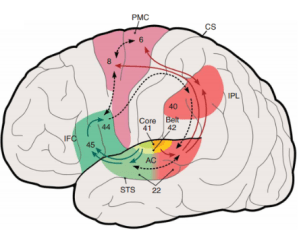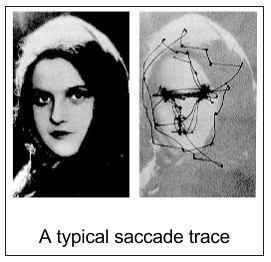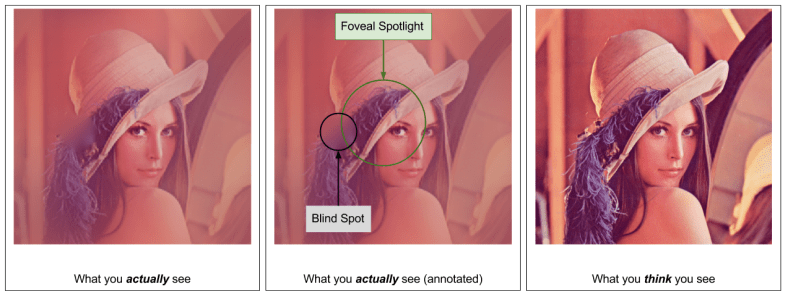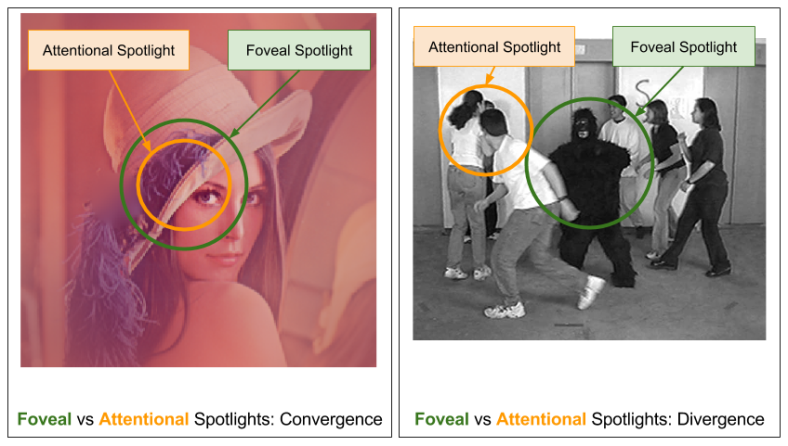Part Of: Attention sequence
Content Summary: 800 words, 8 min read
No one denies attention is intimately related to consciousness. But how much do you know about attention? Does it feel like a synonym for consciousness?
Today, we will be learning about some interesting software suspended above your perceptual systems: the attentional spotlight.
Foveal Vision and Saccades
To understand visual attention, I first need to tell you about vision.
Your eyes contain rods & cones. Rods detect light intensity, cones detect light color.
Rods and cones are not distributed evenly. Cones live right behind your pupils, rods live everywhere else.
As this graph makes clear, there are two different types of vision:
- Foveal Vision, located at the center of your field of vision. This system collects detailed information about an object, including the color.
- Peripheral Vision, located at, well, the periphery. This system computes the “gist” of a scene, and detects movement.
Why is there a hole in the above pictures? This blind spot is due to your optic nerve intruding on your retina. Natural selection can sometimes design itself into a corner. Animals inhabiting different evolutionary lineages, such as octopi, do not suffer this problem.
Foveal vision is very narrow. In order to get more detail, your eyes have to move. Specifically, your foveal spotlight needs to travel from point to point, slowly adding detail to your understanding of a scene.
Such eye movements are known as saccades. Saccades usually operate subconsciously. With modern imaging technology, we can graph precisely how your eyes move over an image. Consider, for example, a saccade trace over the following portrait:
Why are saccades drawn to the eyes? Let me answer that question a bit later.
Let’s return to the question of (foveal) color vision. I’ve shown you two distinct features in this system:
- Foveal Spotlight: only objects in the very center of your vision are in clear focus.
- Blind Spot: you are literally blind in one particular spot in your field of vision. (If you like, you can prove this to yourself).
Crucially, neither the spotlight nor the blind spot enter conscious awareness:
This is a bit unsettling. We literally see less than we think. Somewhere between perception and the Mental Movie, our brains inject an illusion of transparency. Such “false wholeness” effects should give us pause.
Overt vs Covert Attention
We can now explain visual attention! 🙂 Suppose I give you the above picture and say, “pay attention to the shape of her nose”. How do you respond?
Your eyes would most likely trace a saccade until your foveal spotlight was centered above her nose. A detailed image of her nose would then probably appear in your Mental Movie. Are we done? Is this an adequate description of the biology of attention?
Before declaring victory, consider sound. Imagine deciding to pay attention to the cello section of an orchestra. Is there an acoustic equivalent of a saccade, through which your body can amplify this particular frequency? Absolutely not. (Tilting your head won’t work, because that addresses your ability to detect directional sound).
Another counterexample comes from proprioception, the sense of the orientation of your limbs (as reported by nerves in your muscles). Here too, there is no way your body to “zoom in” on any limb. Yet it is possible to hold specific body parts in the center of your conscious experience.
Thus, attention doesn’t require assistance from mechanisms like saccades. The attentional spotlight is thoroughly independent. We can call unassisted cases of attention (e.g., sound) covert attention, and “enhanced” versions of attention (e.g., vision) overt attention.
This approach is confirmed by a careful study of visual experience. The foveal spotlight and the attentional spotlight can come apart. While these two spotlights often converge, sometimes they attentional spotlight will broadcast the contents of peripheral vision (as any driver can attest). Inattentional blindness is another striking example of the two spotlights diverging: even surprising stuff – like a gorilla – can escape detection, despite their placement within the foveal spotlight.
We can now improve our understanding of overt attention. In vision, overt attention moves the foveal spotlight (“green flashlight”) so that it follows the attentional spotlight (“orange flashlight”). In this ways, your eyes seek to “enhance” your conscious experience by feeding it more detail.
Takeaways
- Foveal and peripheral vision create detailed and coarse descriptions, respectively.
- Your vision system have two flaws: a blind spot, and a narrow foveal spotlight.
- Attention is also a spotlight, delivering a subset of experience to the Mental Movie.
- Often, the attentional spotlight moves on its own (covert attention).
- Sometimes, the attentional spotlight is amplified by e.g., saccades (overt attention).
- Inattentional blindness shows how the foveal spotlight separates from the attentional spotlight.
Next time, we will examine how visual attention relates to consciousness.




